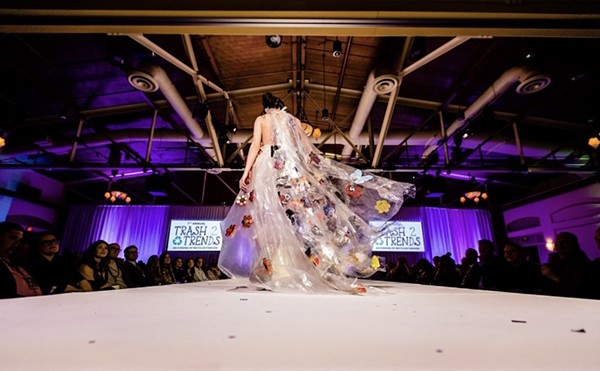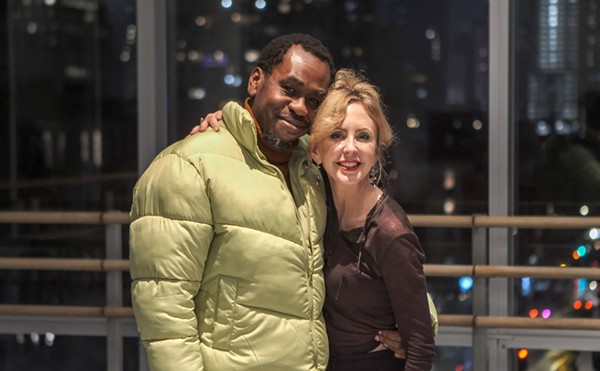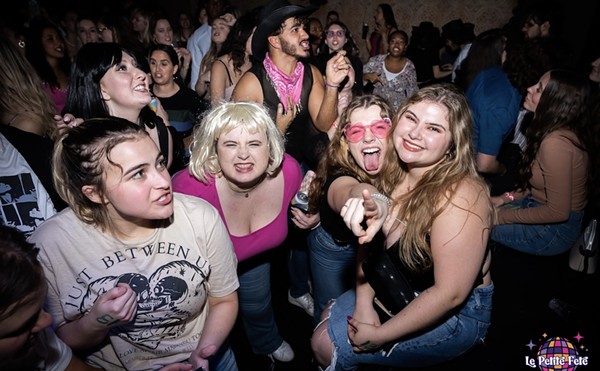In front of a garbage-strewn stoop in the red-light district of Bombay, 12-year-old Marie stands barefoot in a tattered bride's dress; in three days she, like her mother before her, will be sold into a brothel. In Calcutta, five women in miniskirts and heels primp in front of a full-length mirror, getting ready for a Valentine's Day party. In a cramped trailer, a family of magicians poses in full circus costume of top hats and sequins.
These are some of the faces of India captured by photographer Dayanita Singh, whose work is currently on display at the Crealde School of Art. It is a fascinating, stark and beautiful collection of black-and-white photos that capture the poverty, poetry and pride of the world's second-largest country.
This exhibit is drawn from more than 15 years of Singh's photography. Citing the influence of her mother, "who took hundreds of beautiful, candid shots" of her, Singh studied at the National Institute of Design in Ahmedabad, India, and then interned in New York with international photographer Mary Ellen Mark. Under Mark's influence, Singh began to realize the power of the camera when she went to shoot an Indian tabla player.
"His single-mindedness amazed me," says Singh, "and I realized then what a powerful world the camera could open to me if I was willing to dedicate my life to it."
Naively feeling that perhaps her photos could bring about social change, Singh began to take India's sex workers, street children and circus performers as her subjects. The resulting works are disturbing and touching portraits of poor, desperate people. In one, three children of prostitutes are playing dress-up, crudely applying rouge from an old soup can and tying bows in their hair, seemingly destined to follow in their mothers' footsteps. Their slight smiles hint at an innocence that their squalid surroundings have not yet squashed.
For several years Singh continued to depict the downtrodden of India, until she shot the young girl Marie in the bride's dress. "After I shot Marie, she came running over to me and begged me to take her away. She didn't want to become a prostitute. I told her there was nothing I could do." Singh realized her photos had not made a difference and felt she had become voyeuristic.
As a result, she turned to different subjects. She began shooting the vast middle class of India, which is quickly changing due to the influx of Western capitalism. In one of Singh's photos, a young girl walks through her Westernized Calcutta home in a European dress talking on a portable phone. A grandfather clock and a classical European bust decorate the room, dominating a tiny Indian sculpture on the mantle. In another picture, a wealthy matriarch poses on an elegant couch surrounded by life-size imitation Rococo paintings she had commissioned after seeing them in an art book.
Sadly, Singh found that the editors who had gobbled up her pictures of prostitutes and carpet-factory children weren't interested in images of domesticity; they wanted the exotics and grotesques. "They would say, ‘Oh this must be Indians in Miami or London. This can't be India.' And I would say, ‘No, that's my mother, my cousin and two friends of mine.' A battered woman is not the national symbol of India."
As the rest of the world slowly accepts her homeland's changing cultural identity, Singh continues to develop her subject matter. She has started to photograph the new icons of the upper middle class by focusing on beauty pageants, religious functions, "kitty parties" given for bored housewives, and Hindi film sets. In one photo from this era, two beauty-pageant contestants are walking onstage in swimsuits while just offstage, three waiting contestants stand petrified, their bathing suits covered by traditional Indian clothing.
Such images are still met with perplexed resistance. "Sometimes I feel like I'm on an island," says Singh. "The rest of the world and India don't want to see this side of India. It's too personal."

















